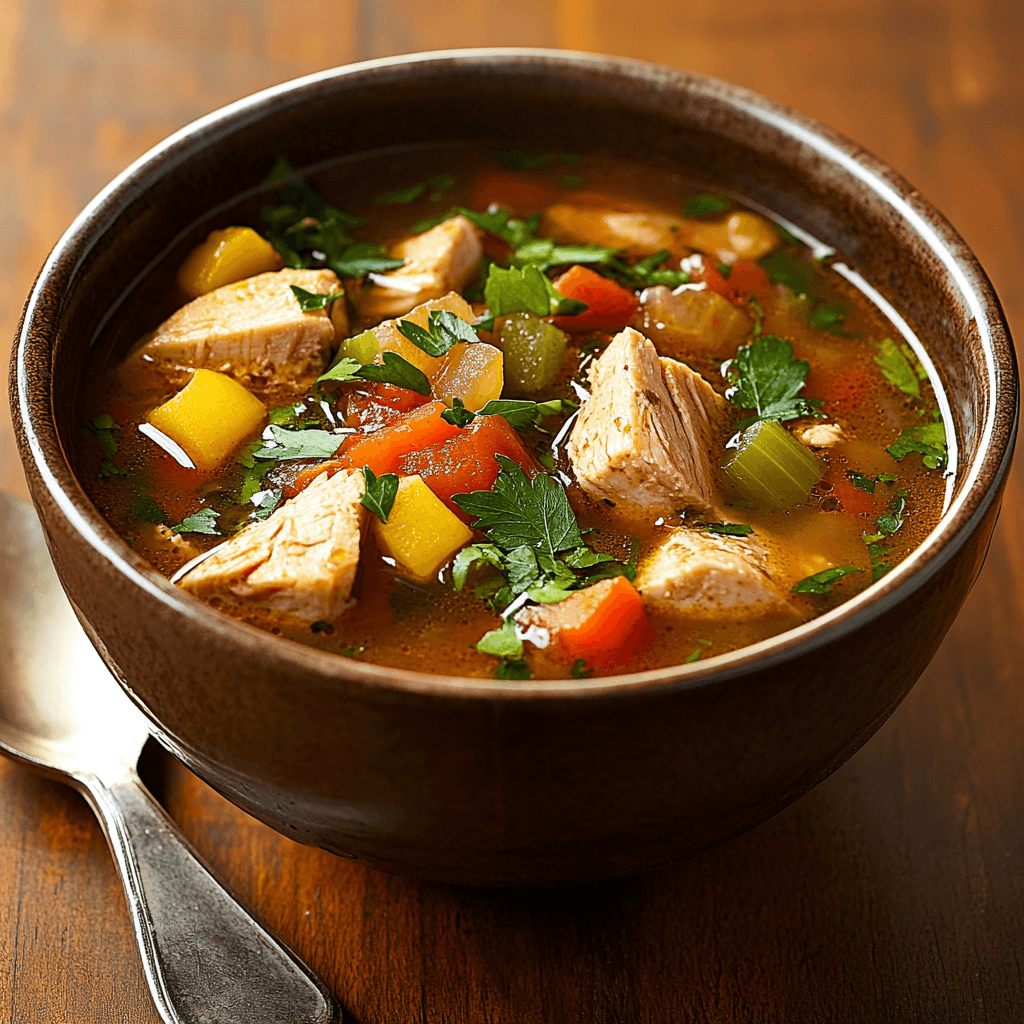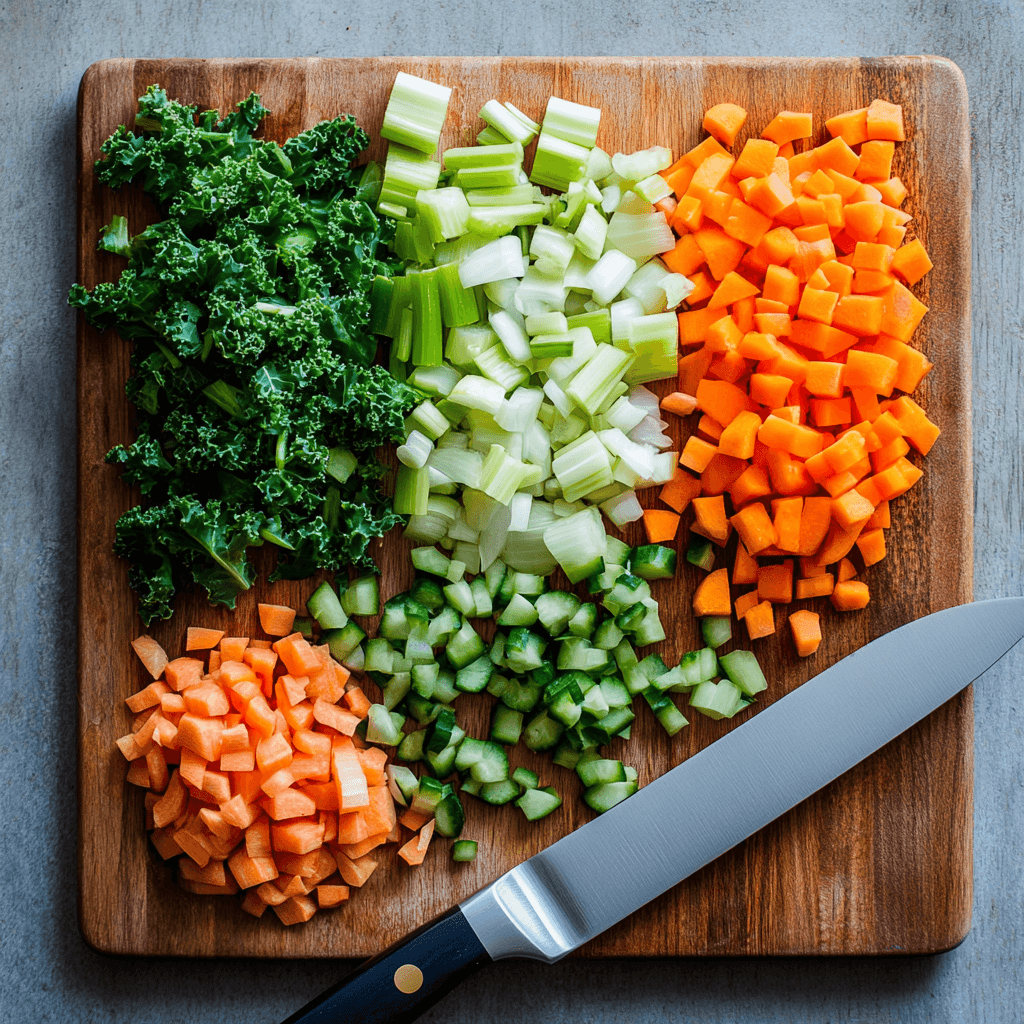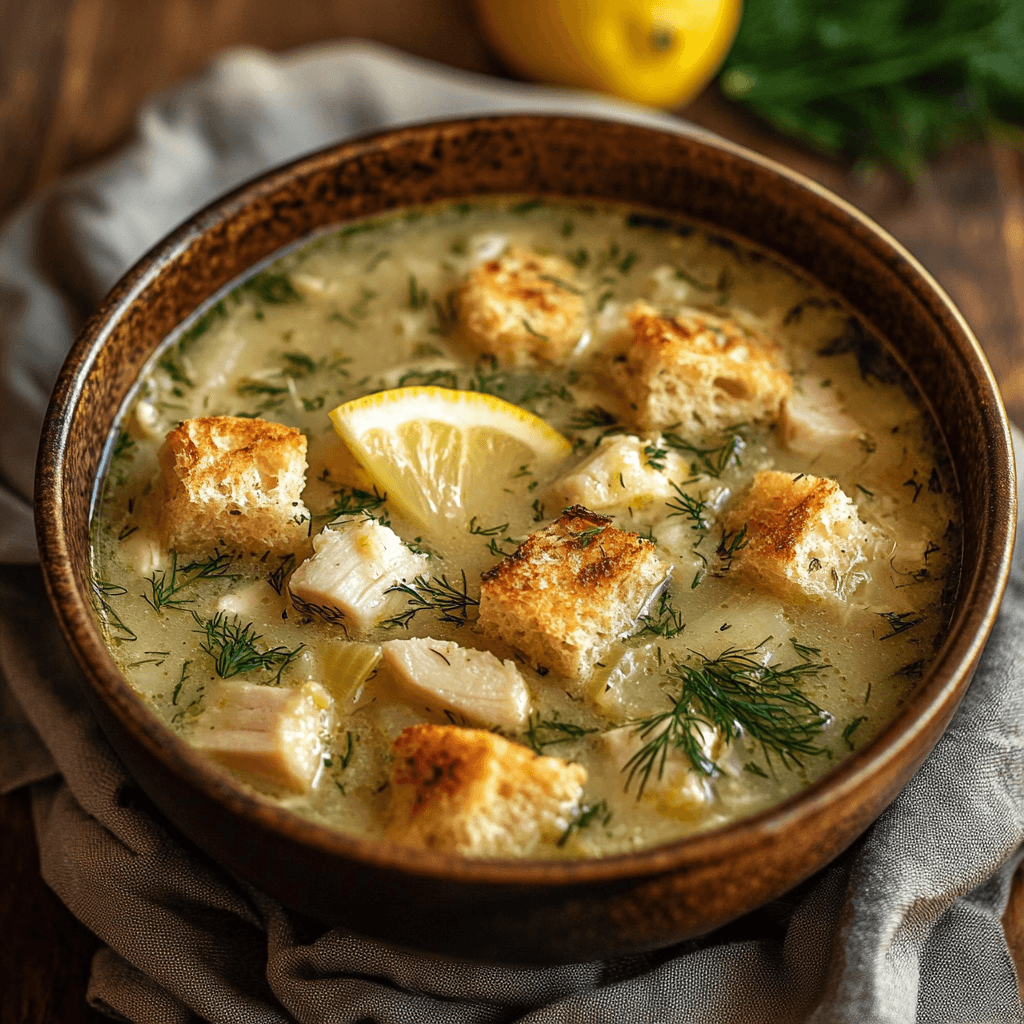Table of Contents

Soup is more than just a warm, comforting meal—it’s a dish that can nourish the body and soothe the soul. A flavorful soup has the power to transform a simple gathering into a memorable experience, making it a staple in cuisines worldwide. Turkey soup, in particular, is a favorite for using up leftovers after festive meals, providing a hearty option that minimizes food waste.
However, despite its potential, turkey soup often falls short of expectations. A common complaint is that it can turn out bland, lacking the depth and richness that make soups satisfying. This can happen for several reasons:
- Under-seasoning: Skimping on spices, herbs, or salt often leads to a lackluster taste.
- Weak Stock: Using water instead of a robust stock or broth results in a less flavorful base.
- Imbalance in Ingredients: Overcooked vegetables, a disproportionate ratio of turkey to liquid, or insufficient aromatics can all contribute to a dull outcome.
- Missed Enhancements: Overlooking simple tricks, such as adding acidity or umami elements, can leave the soup feeling one-dimensional.
Understanding these challenges and addressing them effectively can elevate your turkey soup into a rich, flavorful dish that delights your palate and warms your heart.
Understanding the Basics of Flavor Turkey Soup
To make a turkey soup flavorful, it’s important to understand the foundation of taste. Every dish, including soup, relies on a balance of the following key flavor profiles:
- Salty: Salt enhances natural flavors and balances sweetness and bitterness.
- Sweet: A hint of sweetness can counterbalance acidity and bitterness. Ingredients like carrots or a dash of sugar work well.
- Sour: Acidity from vinegar or lemon juice adds brightness and cuts through richness.
- Bitter: Subtle bitterness, such as from kale or parsley, adds complexity.
- Umami: This savory flavor, found in mushrooms, soy sauce, or miso, adds depth.
Mastering these flavor elements is the first step to turning a bland soup into a dynamic and exciting dish.
Assessing the Current State: Identifying Why Your Turkey Soup Tastes Bland
When your turkey soup falls flat, it’s essential to pinpoint the reasons behind its lack of flavor. Identifying common mistakes and oversights can help you transform your soup into a rich, satisfying dish. Here are some potential culprits to consider:
1. Under-Seasoning
- Lack of Salt and Pepper: These basic seasonings are crucial for enhancing natural flavors.
- Neglecting Herbs and Spices: A soup without aromatic herbs like thyme, rosemary, or bay leaves often tastes dull.
2. Weak Stock or Broth
- Using Plain Water: Water lacks the depth and complexity needed for a flavorful base.
- Diluted Broth: Adding too much liquid to the soup can weaken the flavor.
3. Missing Aromatics
- Skipping the step of sautéing onions, garlic, and celery means missing out on the caramelized sweetness and aroma they bring.
- Inadequate use of foundational vegetables like carrots or leeks can result in an unbalanced base.
4. Overcooked or Bland Ingredients
- Overcooked turkey can become dry and lose its taste, contributing little to the soup.
- Mushy vegetables can detract from the overall texture and flavor profile.
5. Lack of Acidic Balance
- Without a splash of acidity, such as lemon juice or vinegar, the soup can feel flat or too heavy.
- Acidity is essential to brighten and balance the flavors.
6. Absence of Umami Boosters
- Failing to incorporate ingredients like soy sauce, Parmesan, mushrooms, or Worcestershire sauce can result in a lack of savory depth.
7. Neglecting Freshness
- Forgetting to add fresh herbs or greens at the end can leave the soup tasting one-dimensional.
- A fresh garnish like parsley or green onions adds vibrancy and visual appeal.
8. Poor Texture Management
- A soup that is too watery or lacks varied textures can feel unappealing.
- Not including hearty additions like pasta, rice, or barley may leave it feeling incomplete.
By carefully evaluating these factors, you can uncover why your turkey soup tastes bland and take the necessary steps to enhance its flavor. Small adjustments can make a big difference in creating a delicious, well-rounded dish.
Using Seasonings and Spices

One of the easiest ways to rescue bland turkey soup is by incorporating a variety of spices and seasonings.
Common Pantry Spices to Add Flavor
Start by adding familiar spices from your pantry to amplify the soup’s flavor:
- Bay Leaves: Add earthy notes that deepen the broth.
- Thyme: Complements turkey with its herbaceous, slightly minty flavor.
- Paprika: For a smoky or sweet kick, depending on the variety.
- Black Pepper: Enhances the overall taste with a warm, spicy edge.
- Cumin: Adds a warm, nutty flavor that pairs well with turkey.
How Fresh Herbs Can Elevate Soup Flavor
Fresh herbs provide a burst of brightness that dried herbs can’t always match:
- Parsley: Use it as a garnish for a clean, grassy taste.
- Cilantro: Adds a unique, citrusy touch, especially if you’re leaning toward a Mexican flavor profile.
- Dill: Complements turkey’s mild flavor beautifully, adding a delicate, tangy aroma.
Pro Tip: Add dried spices early during cooking to release their flavors, but incorporate fresh herbs just before serving for maximum impact.
Adding Aromatics for Depth
Aromatics are the building blocks of a flavorful soup, offering a base of richness and complexity.
The Role of Onions, Garlic, and Celery
The classic trio of onions, garlic, and celery (often referred to as mirepoix when combined with carrots) lays the groundwork for deep, savory flavors.
- Onions: Add sweetness as they caramelize. Use white or yellow onions for a neutral flavor or red onions for a touch of tang.
- Garlic: Brings a robust, pungent flavor that intensifies as it cooks.
- Celery: Adds a subtle herbal note and balances the soup’s overall profile.
Unique Aromatics to Try
If you want to experiment, consider adding these ingredients:
- Leeks: Their mild, sweet flavor complements turkey without overpowering.
- Fennel: Adds a hint of licorice-like sweetness for a Mediterranean twist.
- Shallots: These small, delicate onions provide a sweeter, more nuanced flavor than regular onions.
Enhancing the Broth
The broth is the heart of any soup, and elevating its flavor can transform your turkey soup from bland to extraordinary. Here are some practical tips to enhance the richness and depth of your broth:
1. Start with Quality Stock
- Use homemade turkey or chicken stock whenever possible, as it provides a richer flavor compared to store-bought options.
- If using store-bought broth, choose low-sodium varieties and adjust the seasoning to your taste.
2. Concentrate the Flavor
- Reduce the Broth: Simmering the broth uncovered allows excess water to evaporate, concentrating the flavors.
- Add a bouillon cube or concentrated stock paste for an instant flavor boost.
3. Sauté Aromatics First
- Sauté onions, garlic, celery, and carrots in a bit of butter or oil before adding them to the soup. This caramelization process deepens the broth’s flavor.
- Include leeks or shallots for additional sweetness and complexity.
4. Incorporate Herbs and Spices
- Add bay leaves, thyme, rosemary, or parsley stems to infuse the broth with earthy and aromatic notes.
- Consider whole spices like peppercorns or a pinch of nutmeg for subtle warmth.
5. Add Acidity for Balance
- A splash of white wine, vinegar, or a squeeze of lemon juice can brighten and balance the broth.
- Tomatoes or a dollop of tomato paste can add both acidity and a slight sweetness.
6. Infuse Umami Depth
- Incorporate soy sauce, Worcestershire sauce, or a spoonful of miso paste for a savory umami punch.
- Add dried mushrooms or a Parmesan rind while simmering for a boost in complexity.
7. Enhance with Fat
- Stir in a pat of butter or a drizzle of olive oil to add richness and a silky mouthfeel.
- For a creamy texture, blend in a small amount of heavy cream or coconut milk.
8. Taste and Adjust
- Continuously taste the broth as it simmers and adjust the seasoning with salt and pepper to ensure a well-balanced flavor.
- If the broth feels too salty, balance it by adding a raw potato to absorb excess salt, then remove it before serving.
9. Simmer with Care
- Avoid boiling the broth aggressively, as it can muddy the flavors. A gentle simmer allows all the ingredients to meld harmoniously.
By focusing on these techniques, you can elevate your turkey soup’s broth, ensuring it becomes the flavorful foundation for a delicious and satisfying meal.
The Importance of Good-Quality Broth
- Homemade turkey stock is ideal, made from the carcass of your roasted turkey, along with vegetables and herbs simmered for hours.
- If using store-bought broth, opt for low-sodium varieties to control the seasoning.
Adjusting the Base
- Bouillon Cubes or Broth Concentrates: These are excellent for intensifying flavor in a pinch.
- Bone Broth: Adds a gelatinous texture and deeper flavor due to collagen and minerals.
Pro Tip: Simmer the soup uncovered for a while to reduce and concentrate the broth’s flavor.
Incorporating Acidity
A touch of acidity can instantly brighten turkey soup, making the flavors more vibrant and well-rounded.
Adding Lemon Juice or Vinegar To Turkey Soup
- Lemon Juice: A squeeze of fresh lemon juice at the end of cooking adds brightness without overpowering the soup.
- Vinegar: Balsamic, apple cider, or white wine vinegar can provide subtle tanginess. Use sparingly to avoid an overly sour taste.
Using Tomatoes for a Subtle Tang
- Fresh or Canned Tomatoes: A small amount of diced tomatoes or tomato paste can add both acidity and umami, enriching the soup’s depth.
Pro Tip: Always taste as you go when adding acidic ingredients to ensure you achieve the right balance.
Adding Umami for Richness
Umami, the savory “fifth taste,” can transform a bland soup into a robust dish.
Ingredients for Umami Depth
- Soy Sauce or Tamari: Add a splash to your soup for a salty, savory boost. Tamari is a great gluten-free alternative.
- Miso Paste: Stir in a spoonful for a creamy, umami-rich broth with a slightly nutty flavor.
- Mushrooms: Fresh or dried mushrooms, such as shiitake or porcini, provide an earthy, meaty flavor.
- Fish Sauce: Just a few drops of this potent ingredient can elevate the soup’s savoriness without tasting “fishy.”
Using Parmesan Rinds
A leftover rind from Parmesan cheese can be simmered in the soup for a subtle, cheesy umami flavor. Remove the rind before serving.
Incorporating Textural Enhancements
Texture can be just as important as flavor when making a satisfying soup.
Adding Crunch with Toppings
- Croutons: Toasted bread cubes add crunch and a hint of garlic or herbs if seasoned.
- Nuts and Seeds: Sprinkle toasted sunflower seeds, pumpkin seeds, or chopped almonds for a crunchy topping.
Using Dairy or Cream Alternatives
- Heavy Cream or Half-and-Half: Swirl in for a velvety texture.
- Coconut Milk: A dairy-free option that adds creaminess and a slight sweetness.
- Greek Yogurt: Adds tanginess and creaminess when stirred in or dolloped on top.
Pro Tip: Blend a portion of the soup to create a naturally creamy texture while leaving the rest chunky for contrast.
Boosting Protein or Vegetables

Enhancing turkey soup with additional protein and vegetables not only makes it more nutritious but also adds complexity to the flavor and texture.
Adding Roasted Turkey or Other Proteins
- Leftover Turkey: Use shredded roasted turkey for a smoky, rich flavor that enhances the broth.
- Beans and Lentils: Chickpeas, white beans, or red lentils add protein and a creamy texture.
- Eggs: Whisked eggs can be slowly stirred into the hot soup to create ribbons, similar to egg drop soup.
Choosing Flavorful Vegetables
- Root Vegetables: Carrots, parsnips, and turnips add sweetness and body. Roast them first for deeper flavors.
- Leafy Greens: Kale, spinach, or Swiss chard can be stirred in toward the end for added nutrients and color.
- Corn or Peas: These add a touch of sweetness and a pop of texture.
Pro Tip: Sauté vegetables in olive oil or butter before adding them to the soup to bring out their natural flavors.
Experimenting with Garnishes

The right garnish can take your turkey soup from ordinary to extraordinary.
Fresh Herbs and Citrus Zest
- Fresh Herbs: Sprinkle chopped parsley, cilantro, or chives for a burst of freshness.
- Citrus Zest: Grate lemon, lime, or orange zest over the soup to add an aromatic finish.
Creamy and Crunchy Finishes
- Dollop of Yogurt or Sour Cream: Adds creaminess and tang to each spoonful.
- Toasted Seeds or Croutons: Provide a delightful crunch and a complementary flavor.
Spicy Enhancements
- Chili Oil: Drizzle a bit for a hint of heat.
- Crushed Red Pepper Flakes: Sprinkle for a spicy kick.
- Hot Sauce: A splash can brighten the soup while adding heat.
Pro Tip: Garnishes should not only enhance flavor but also create visual appeal, making your soup look as good as it tastes.
Pro Tips for Flavored Turkey Soup
To ensure your turkey soup is packed with flavor every time, keep these expert tips in mind:
Storing and Reheating Soup
- Refrigerate Overnight: Letting the soup sit overnight allows the flavors to meld and intensify.
- Reheat Gently: Warm soup on low heat to preserve its flavor and prevent overcooking delicate ingredients.
Adjusting Seasoning After Resting
Soup flavors can change over time. After reheating, taste the soup again and adjust with:
- Salt: Enhance overall flavor if it tastes dull.
- Acidity: Add lemon juice or vinegar if it seems too heavy.
- Spices: Sprinkle additional black pepper, paprika, or herbs for a final boost.
Freezing for Later
- Use Airtight Containers: Divide soup into portions and store in airtight containers to retain freshness.
- Label and Date: Keep track of when you froze the soup to enjoy it at its peak.
Pro Tip: Freeze soup without toppings or garnishes; add them fresh after reheating for the best texture and flavor.
Frequently Asked Questions (FAQs) Turkey Soup
What spices work best in turkey soup?
Bay leaves, thyme, paprika, and black pepper are classic options, but cumin or chili flakes can add a unique twist.
Can I fix bland turkey soup without starting over?
Absolutely! Start by adjusting salt and acidity, then add umami boosters like soy sauce or mushrooms. Spices and fresh herbs can also save the day.
What are the best herbs for turkey soup?
Fresh parsley, cilantro, dill, and thyme work wonderfully. Dried herbs can also add depth if fresh ones aren’t available.
How do I make my turkey soup creamy without dairy?
Blend a portion of the soup for natural creaminess or add coconut milk for a dairy-free alternative.
Why does soup taste better the next day?
Resting overnight allows the flavors to meld and deepen, creating a more cohesive and flavorful dish.
Can I freeze turkey soup without losing flavor?
Yes! Freeze the soup in portions, leaving out toppings or garnishes until you’re ready to serve.
Conclusion Turkey Soup
A flavorful turkey soup is not just about satisfying hunger—it’s an opportunity to create a comforting and memorable dish. By addressing common pitfalls and employing simple yet impactful techniques, you can transform a bland soup into a culinary delight.
Start by enhancing the broth, the backbone of the soup, with quality stock, aromatics, and umami-rich ingredients. Add herbs, spices, and acidity to balance and elevate the flavors. Experiment with textures and fresh garnishes, such as vibrant greens or crunchy croutons, to make the dish more dynamic and visually appealing. Above all, taste and adjust as you go, ensuring each element contributes to a harmonious whole.
Cooking is a creative journey, and turkey soup is a perfect canvas for trying new ingredients and techniques. Don’t be afraid to experiment with bold flavors, unexpected spices, or personal touches that reflect your style. By applying these methods, you’ll not only rescue bland turkey soup but also develop the skills to innovate and enjoy the process of cooking.
Print
How to Add Flavor to Bland Turkey Soup?
- Total Time: 40 minutes
- Yield: 4 servings 1x
Description
A gentle, comforting soup made with turkey, vegetables, and simple seasonings. This recipe is great for anyone looking for something light and easy to digest.
Ingredients
Broth Base
- 8 cups water
- 1 lb cooked turkey, shredded or diced
- 2 bay leaves
Vegetables
- 2 medium carrots, peeled and diced
- 2 celery stalks, diced
- 1 medium potato, peeled and cubed
- 1 small onion, peeled and quartered
Seasonings (mild)
- 1 tsp salt (adjust to taste)
- 1/4 tsp ground white pepper (optional for a hint of warmth)
Instructions
Prepare the broth:
- In a large stockpot, combine water, turkey, and bay leaves. Bring to a gentle boil over medium-high heat.
Add the vegetables:
- Add carrots, celery, potato, and onion to the pot. Reduce heat to low and simmer uncovered for 25–30 minutes until vegetables are tender.
Season lightly:
- Stir in salt and optional white pepper. Adjust seasoning to taste.
Finish and serve:
- Remove the bay leaves and onion quarters (if desired). Ladle the soup into bowls and serve warm.
Notes
- Optional Add-Ins: If you want more flavor later, try adding fresh herbs (parsley or thyme), a squeeze of lemon, or a dash of garlic powder.
- Storage: Store in an airtight container in the refrigerator for up to 3 days or freeze for up to 3 months.
- Texture Tip: Mash some of the potato cubes for a slightly thicker broth.
- Prep Time: 10 minutes
- Cook Time: 30 minutes
- Category: Soup
- Method: Simmering
- Cuisine: American
